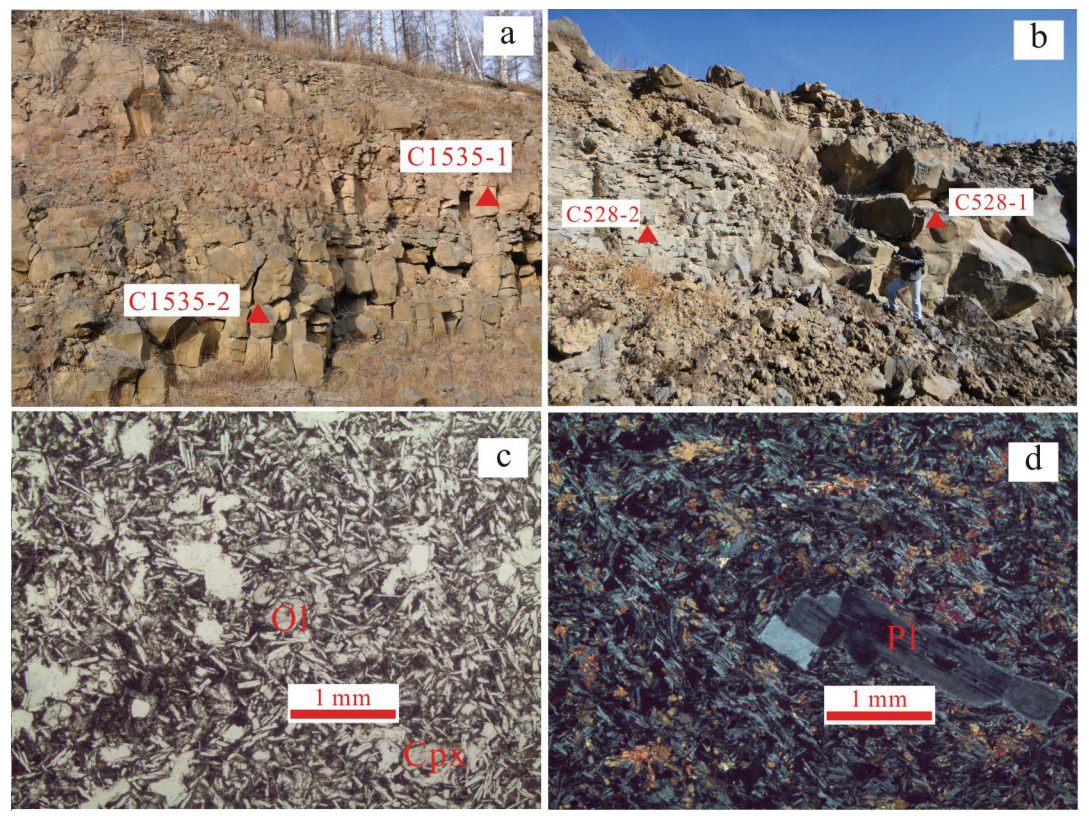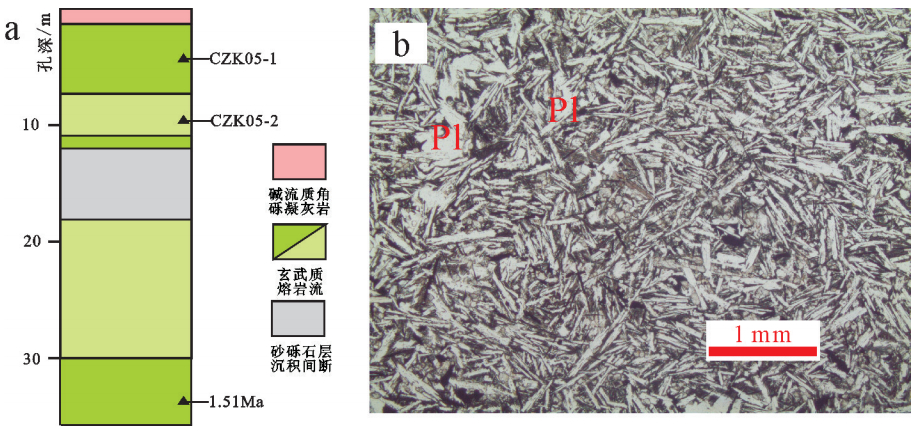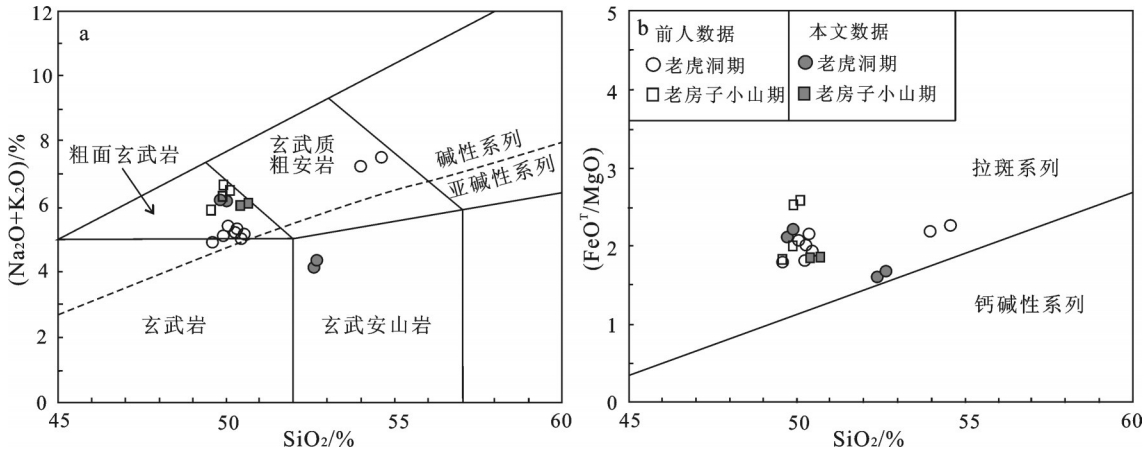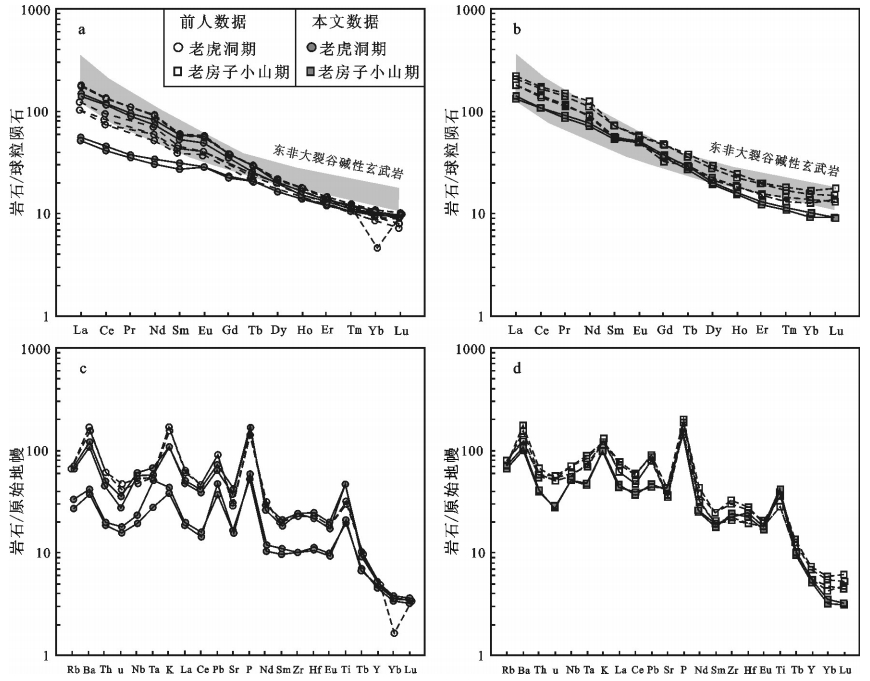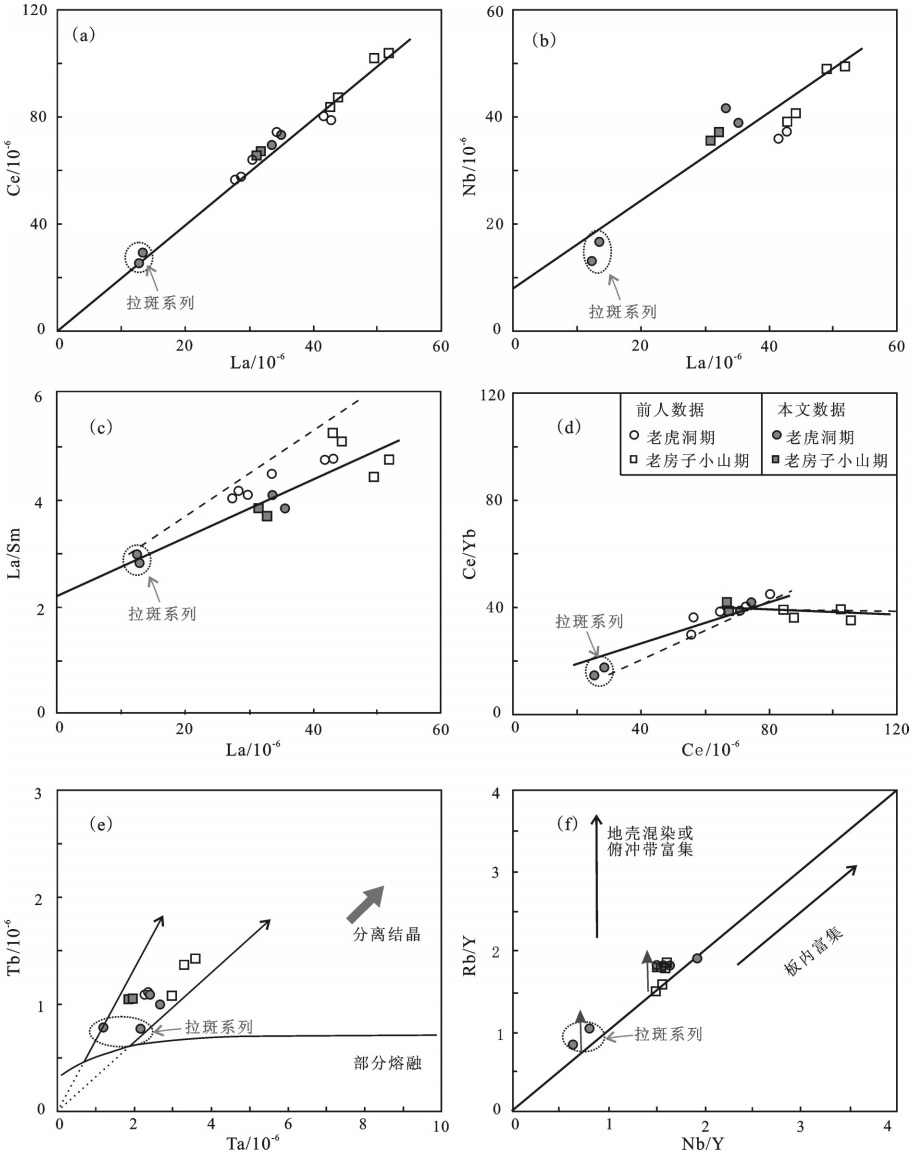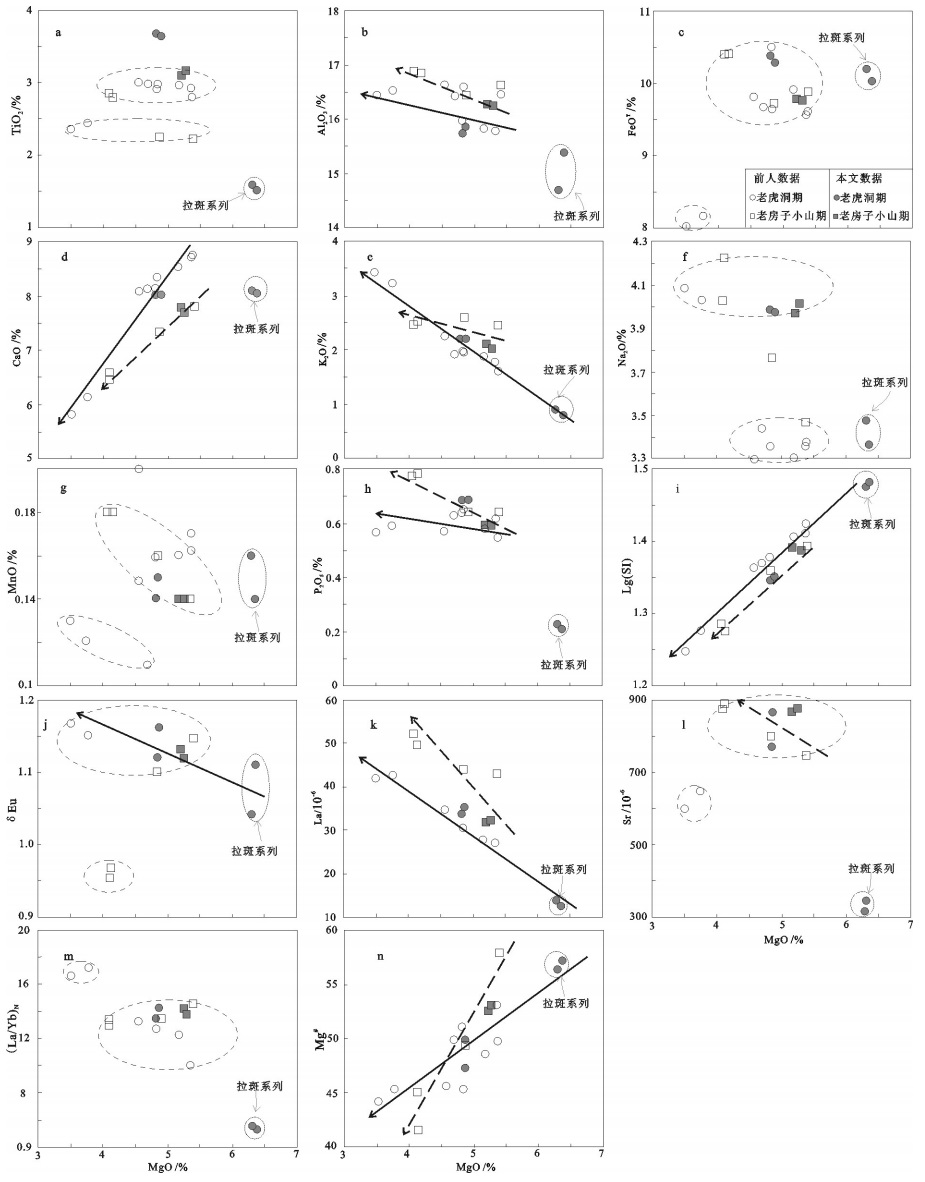Stage division and genesis discussion of basaltic volcanism during the coneforming stage of Tianchi volcano in Changbaishan region
-
摘要:
在天池火山造锥阶段,长白山火山区玄武质火山活动频繁。文章在野外调查的基础上,通过年代学及地球化学研究,对其活动期次进行划分,并探讨其岩浆来源与演化。天池火山造锥阶段的玄武质火山岩主要呈火山渣锥或小型河谷玄武岩形式分布,其形成可划分为两期:一期为老房子小山期,形成时限为0.87~0.54 Ma,属碱性岩石系列;另一期为老虎洞期,形成时限为0.34~0.1 Ma,属碱性岩石系列和拉斑岩石系列。地球化学特征显示,碱性系列玄武岩具高Al、Ti、K、P和低Mg特征,拉斑系列玄武岩具高Mg、富Fe、Ca和低Na特征;二者稀土和微量特征较为一致,稀土元素配分曲线呈右倾型,略显正铕异常,并富集Ba、K、Pb、P、Ti,亏损Th、U、Sr,但拉斑系列玄武岩的稀土元素和微量元素含量及轻重稀土分馏强度均低于碱性系列。天池火山造锥阶段形成的玄武质火山岩均来源于进化岩浆,具有同源特征,经历了一致或相似的演化过程,岩浆房赋存位置相当于上地幔-下地壳的过渡部位,结晶分异岩浆作用显著、地壳混染作用微弱,其成分变化受控于多期次结晶分异作用和早期结晶再循环的岩浆作用过程。
Abstract:During the cone-forming stage of Tianchi volcano, activity of basaltic volcanism was frequent. In this paper, based on field geological survey and analysis of chronology and geochemistry, the authors determined active stages of the basaltic volcanism, and investigated magmatic source and evolution. The results show that the activity of the basaltic volcanism forming scoria cones or mini valley basalt can be divided into 2 stages:Laofangzixiaoshan period (about 0.87-0.54 Ma) belonging to alkaline basaltic volcanism and Laohudong period (about 0.34-0.1 Ma) belonging to alkaline and tholeiitic volcanism. Alkaline basalt is rich in Al, Ti, K and P, and poor in Mg, and tholeiite is rich in Mg, Fe and Ca, and poor in Na. The two types of basalt have similar characteristics in REEs, trace elements and Eu anomalies, exhibiting obvious right-declined REE patterns, slightly positive Eu anomalies, enrichment of Ba, K, Pb, P and Ti, and depletion in Th, U and Sr. Nevertheless, in contrast to alkaline basalt, content of REEs and trace elements, and fractional degree of HREE and LREE are lower in tholeiite. The basalt formed during the coneforming stage of Tianchi volcano was derived from evolutional magma, and was identical with the transitional position of uppermantle and lower-crust, which had characteristics of common fountain, and had the same or similar evolution process with significant crystallization differentiation and faint crustal contamination. Compositions of the evolutional magma were controlled by multi-stages crystallization differentiation and recirculation during early crystallization.
-
长白山天池火山位于吉林省东部的中朝边境地区,晚新生代以来持续活动,火山灾害巨大,为地球上最大的活火山之一[1]。20世纪60年代,在长白山地区开展了漫江幅和长白幅1:20万区域地质调查,初步揭开了长白山火山的神秘面纱。20世纪80年代以来,学者们针对天池火山的成因、形成过程、岩浆演化、活动期次、喷发机制等进行了大量研究,并取得了一系列的成果[1-17]。刘若新等针对天池火山的形成演化进行了较为系统的总结,认为其相继经历了玄武质火山岩造盾阶段、粗面质火山岩造锥阶段和碱流质火山大爆发阶段3个演化过程[5]。有学者对各过程的形成时代和特征进行总结,上新世-早更新世早期的玄武质火山活动形成天池火山下部及其周边的玄武岩盾[5, 6, 12, 18],形成时间为4.5~1.2 Ma[5, 16];早更新世晚期-晚更新世中心式粗安-粗面质火山活动形成天池火山锥的主体[2, 6, 7],形成时间为1.0~0.01 Ma[5, 14-15, 19];全新世中心式粗面-碱流质爆炸式火山活动,形成天池火山锥体上大面积分布的火山碎屑流堆积和空降堆积、及锥体周边主要沿河谷分布的火山泥石流堆积[2, 5, 12]。
前人在长白山火山区发现大量形成于天池火山造锥阶段(约1 Ma以来)的玄武质火山渣锥及小规模的熔岩流,并进行了大量的年代学测试[2, 5-7, 14, 20]。有学者在讨论天池火山演化和长白山玄武岩演化时提及了本套玄武质火山岩,并侧重探讨其在长白山火山演化和喷发中的意义[5, 9, 14];也有学者侧重其成分特征的研究,并对其成因进行解释[17]。对本套玄武质岩浆活动的期次划分、来源深度、岩浆作用和喷发机制等认识差异较大或较为局限。鉴于此,本文在野外调查的基础上,对天池火山造锥阶段长白山火山区形成的玄武质火山岩进行年代学及地球化学研究,结合前人的测试数据及认识,对其进行期次划分,确定其活动时限,并探讨其岩浆来源与演化。
1. 区域概况及采样位置
长白山火山区呈现山地地貌,沟壑纵横、地形复杂、相对高差较大[21]。大地构造位置上,位于西太平洋板块俯冲带的前沿,中朝板块的北缘[10, 22]。结合区域地质调查资料及朝鲜地区的相关资料,根据物质组成及形成时代,将晚新生代火山岩地层由老到新划分为中新世玄武岩、上新世-早更新世早期玄武岩、早更新世晚期-晚更新世玄武岩、早更新世粗面岩、中更新世粗面岩、早更新世晚期-晚更新世粗面岩和全新世粗面-碱流质火山喷发物等(图 1),并划分为土顶子、天池、小白山、望天鹅、胞胎山和黄峰等6个大型破火山口[21]。长白山火山造盾阶段形成了区内大面积分布的上新世-早更新世早期玄武岩,天池火山造锥阶段和大爆发阶段形成了天池周边分布的早更新世晚期-晚更新世粗面岩和全新世粗面-碱流质火山喷发物。
![]() 图 1 研究区地质简图(据[21]修改)1-全新世火山喷发物;2-早更新世晚期-晚更新世粗面岩;3-中更新世粗面岩;4-早更新世粗面岩;5-早更新世晚期-晚更新世玄武岩;6-上新世-早更新世早期玄武岩;7-中新世玄武岩;8-破火山口;9-本次采样点位置及编号;10-前人采样点及K-Ar测年结果Figure 1. Geological map of the study area (modified after reference [21])1-Holocene eruptive material; 2-Late stage of Early Pleistocene -Late Pleistocene trachyte, 3-Maddle Pleistocene trachyte; 4-Early Pleistocene trachyte; 5-Late stage of Early Pleistocene -Late Pleistocene basalt; 6-Pliocene -early stage of Early Pleistocene basalt; 7-Miocene basalt; 8-Caldera; 9-Sampling position and serial number; 10-Previous sampling positions and their K-Ar dating results
图 1 研究区地质简图(据[21]修改)1-全新世火山喷发物;2-早更新世晚期-晚更新世粗面岩;3-中更新世粗面岩;4-早更新世粗面岩;5-早更新世晚期-晚更新世玄武岩;6-上新世-早更新世早期玄武岩;7-中新世玄武岩;8-破火山口;9-本次采样点位置及编号;10-前人采样点及K-Ar测年结果Figure 1. Geological map of the study area (modified after reference [21])1-Holocene eruptive material; 2-Late stage of Early Pleistocene -Late Pleistocene trachyte, 3-Maddle Pleistocene trachyte; 4-Early Pleistocene trachyte; 5-Late stage of Early Pleistocene -Late Pleistocene basalt; 6-Pliocene -early stage of Early Pleistocene basalt; 7-Miocene basalt; 8-Caldera; 9-Sampling position and serial number; 10-Previous sampling positions and their K-Ar dating results基于野外调查和研究,区内形成于天池火山造锥阶段的玄武质火山喷发物的分布呈现两个特征:主要呈火山渣锥形式存在,少量以河谷玄武岩形式分布于现代河谷内。图 1中呈现了前人研究的采样位置及K-Ar测年结果,主要分布于广坪村、黑石沟、老房子小山、老虎洞、天池火山锥西南、板石河、赤峰、衡山林场等地。本次工作的采样点分主要分布于前人涉猎较少的图们江上游、头道白河下游和二道白河中游等地区(图 1),针对样品进行了详细的薄片鉴定、岩石地球化学和K-Ar年代学测试工作。
2. 岩相学特征
C1535和C528采样点的野外岩貌特征、采样层位及镜下特征如图 2;CZK05钻钻孔柱状图、采样层位及镜下特征如图 3。
![]() 图 2 野外岩貌和显微薄片照片a-C1535采样点露头及采样位置;b-C528采样点露头及采样位置;c-C1535-2显微薄片特征,单偏光;d-C528-1显微薄片特征,正交偏光;Ol-橄榄石;Cpx-单斜辉石;P-斜长石Figure 2. Photos of rock morphology and micro-sectiona-C1535 sampling point outcrop and sampling position; b-C528 sampling point outcrop and sampling position; c-C1535-2 micro-section (plainlight); d-C528-1 micro-section (crossed nicols) Ol-Olivine; Cpx-Clinopyroxene; Pl-Plagioclase
图 2 野外岩貌和显微薄片照片a-C1535采样点露头及采样位置;b-C528采样点露头及采样位置;c-C1535-2显微薄片特征,单偏光;d-C528-1显微薄片特征,正交偏光;Ol-橄榄石;Cpx-单斜辉石;P-斜长石Figure 2. Photos of rock morphology and micro-sectiona-C1535 sampling point outcrop and sampling position; b-C528 sampling point outcrop and sampling position; c-C1535-2 micro-section (plainlight); d-C528-1 micro-section (crossed nicols) Ol-Olivine; Cpx-Clinopyroxene; Pl-PlagioclaseC1535点采样两个,C1535-1为灰黑色气孔状玄武岩、C1535-2为灰黑色气孔状橄榄玄武岩(图 2-c)。无斑或少斑结构,斑晶由粒状橄榄石组成,粒度约0.5 mm;气孔状构造,呈滴状、港湾状,含量10%;基质呈填间结构,粒度0.1~0.3 mm,板条状斜长石格架中填间辉石、橄榄石颗粒和玻璃质,玻璃质脱玻化,C1535-1基质中部分颗粒大的辉石中镶嵌斜长石晶体,构成含长嵌晶结构。
C528点采样两个,鉴定C528-1为灰色致密块状碱性玄武岩(图 2-d)、C528-2为灰色气孔状碱性橄榄玄武岩。少斑结构,斑晶由自形板状、溶蚀状的基性斜长石组成,粒度0.5~3.5 mm,含量2%;C528-2为气孔状构造,呈圆粒状,含量3%;基质呈间粒-间碱结构,由紫色含钛辉石、基性斜长石、碱性长石和少量粒状伊丁石化橄榄石组成,粒度0.1~0.3 mm,斜长石和碱性长石定向构成似粗面结构镶嵌于含钛辉石颗粒中,构成含长嵌晶结构。CZK05钻中采样两个,CZK05-1和CZK05-2均为灰色气孔状碱性玄武岩(图 3-b)。无斑或少斑结构,斑晶由自形板状基性斜长石组成,粒度1.0~3.5 mm;气孔状构造,呈滴状、港湾状或不规则状,含量5%~10%;基质呈间碱-间粒结构,板条状基性斜长石格架中填间含钛普通辉石、橄榄石、他形碱性长石颗粒和玻璃质,玻璃质脱玻化,部分颗粒大的辉石中镶嵌斜长石晶体,构成含长嵌晶结构,粒度0.1~0.5 mm;CZK05-2基质中部分辉石和长石构成含长嵌晶结构。
3. 形成时限及期次划分
关于天池火山锥体的粗面岩年龄,前人进行了大量的工作。樊棋诚等提供天池火山锥体的粗面岩K-Ar年龄介于1.17~0.08 Ma[14]。本次在天池北侧钻孔中发现一套粗面质角砾凝灰岩夹粗面岩的层序,其中粗面岩K-Ar年龄为0.96 Ma(另文)。金伯禄等在天池南白山林场北侧测得粗面岩K-Ar年龄为1.01 Ma、1.00 Ma[6]。刘若新等在天池北坡冰场东侧测得粗安岩K-Ar年龄为1.12 Ma[23]。魏海泉等和刘强等在双目峰钻孔中获得了多个年龄,孔深30 m的凝灰岩、55 m的粗面岩、93m的凝灰岩和96m的玄武粗安岩的K-Ar年龄分别为0.82 Ma、0.91 Ma、1.14 Ma和1.15 Ma[12, 24]。由此,本文认为长白山天池火山锥体粗面岩的形成下限年龄为1.17 Ma。刘嘉麒在天池-天文峰剖面上部测得粗面岩年龄为0.101 Ma、0.0978 Ma[2]。樊祺诚等在青石峰顶部、铁壁峰顶部、老虎洞东南悬崖、黑风口上部测得粗面岩K-Ar年龄分别为0.13 Ma、0.09 Ma、0.089 Ma、0.08 Ma[14]。由此,本文认为长白山天池火山锥体粗面岩的上限年龄为0.08 Ma。综上,长白山天池火山粗面质锥体形成于1.17~0.08 Ma,为早更新世晚期-晚更新世中心式火山喷发产物。
本次对CAK05钻中和C528点上的玄武岩进行K-Ar年代学测试,结果见表 1。本文收集了20世纪80年代以来学者们对天池造锥阶段玄武岩的K-Ar测年结果(表 2)。测年结果介于1.17~0.08 Ma,与前文讨论的天池火山粗面质锥体的形成时限较为一致。但其分布主体呈现两个区间:一为0.87~0.54 Ma,测试样主要分布于天池火山锥体周边的火山渣锥;另一个区间为0.34~0.1 Ma,测试样分布于天池火山锥体上或周边的现代河谷中,锥体上以老虎洞火山渣锥为代表。前人根据采样地地名和形成时代,将本阶段的玄武质火山活动划分为双峰期[6]、老房子小山期[12]、老虎洞期[6]、黑石沟期❶、板石河期[7]、南平期❷、广坪期[6]、等。本文基于测年结果的分布特征、命名时间的早晚及应用普遍程度,将天池造锥阶段玄武质火山活动划分为两期,一期命名为老房子小山期,形成时限约为0.87~0.54 Ma;另一期命名为老虎洞期,形成时限约为0.34~0.1 Ma。其中老房子小山期火山活动的产物表现为天池火山周边玄武岩盾之上的小型玄武质火山渣锥,而老虎洞期火山活动的产物表现为天池火山锥体上的玄武质火山渣锥或天池火山周边玄武岩盾上现代沟谷中的河谷玄武岩。
❶吉林省地质调查院. 1:50000老跃进林场、白头山、维东、天池等4幅区域地质调查报告[R]. 2000.
❷吉林省地质调查院. 1:250000和龙市幅区域地质调查报告[R]. 2004.
表 1 本次K-Ar测年结果Table 1. The K-Ar ages of basalt 表 2 长白山天池火山造锥阶段玄武质火山岩K-Ar测年结果Table 2. The K-Ar ages of basaltic rocks formed during the cone-forming stage of Tianchi volcano
表 2 长白山天池火山造锥阶段玄武质火山岩K-Ar测年结果Table 2. The K-Ar ages of basaltic rocks formed during the cone-forming stage of Tianchi volcano
❶吉林省地质调查院. 1:50000老跃进林场、白头山、维东、天池等4幅区域地质调查报告[R]. 2000.
4. 岩石地球化学特征
本次全岩成分分析和微量元素分析在国家地质测试分析中心完成。此外,本次地球化学特征研究中还利用了前人的分析测试结果(表 3)。
表 3 长白山天池火山造锥阶段玄武质火山岩岩石地球化学数据及特征参数Table 3. Geochemical data and characteristic parameters of basaltic rocks formed during the cone-forming stage of Tianchi volcano
4.1 主量元素成分特征
长白山火山区的玄武岩呈现碱性和拉斑两个系列[17, 25],本文也进一步验证了此结论。老房子小山期玄武岩里特曼指数(σ)大于3.3,岩性为粗面玄武岩(图 4),结合岩相学分析其属碱性岩石系列。老虎洞期玄武岩特曼指数(σ)分布范围较大,其中σ大于3.3,岩性为粗面玄武岩、玄武粗安岩和碱性玄武岩,σ小于3(C1535点的两个样品),岩性为玄武安山岩(图 4),结合岩相学分析其分别属拉斑岩石系列和碱性岩石系列。两期碱性系列玄武岩的主量元素特征较为一致,均呈现高Al、Ti、K、P和低Mg特征,但老房子小山期的分布较为集中,老虎洞期的分布范围略显宽泛。老虎洞期拉斑系列玄武岩呈现高Mg、富Fe、Ca和低Na特征,且Al2O3、K2O、TiO2和P2O5含量明显低于碱性系列玄武岩。两期玄武岩(无论碱性系列还是拉斑系列)的Mg#介于40~60,呈现进化岩浆特征;固结指数(SI)主体介于20~30,类似于玄武安山质岩浆演化程度。
4.2 稀土与微量元素成分特征
老房子小山期和老虎洞期玄武岩的稀土元素具有相似的配分曲线特征,呈右倾型,略显正铕异常,但碱性系列玄武岩的配分曲线较拉斑系列的右倾斜率偏大(图 5-a、b)。两期碱性玄武岩的曲线特征与东非大裂谷碱性玄武岩的形态相似,老房子小山期表现更为明显(图 5-a、b)。与两期碱性系列玄武岩相比,老虎洞期拉斑系列玄武岩的稀土含量较低、且轻重分馏较弱。而针对两期碱性系列玄武岩而言,稀土总量和轻、重稀土含量较一致;轻重稀土分馏特征较为一致,均表现分馏较强,LREE/HREE介于8~9.5、(La/Yb)N介于13~19。老虎洞期玄武岩略显正铕异常(包括拉斑系列)(δEu=1.04~1.17),而老房子小山期主体略显正铕异常(δEu=1.1~1.14),个别样品铕异常不明显(δEu=0.96和0.97)。
老房子小山和老虎洞期玄武岩的微量元素蛛网图特征较为相似(图 5-c、d)。针对两期碱性系列玄武岩而言,曲线形态及元素含量上较为一致,二者均呈现富集大离子亲石元素Ba、K、Pb和高场强元素P和Ti,亏损高场强元素Th、U及大离子亲石元素Sr,个别样品Nb略显亏损。老虎洞期拉斑系列玄武岩的微量元素分布特征与碱性系列玄武岩相似,但除Y、Yb和Lu外,其他微量元素的含量明显低于碱性系列岩石。
5. 岩浆来源与演化探讨
5.1 岩浆来源
目前普遍认为长白山火山玄武岩起源于软流圈地幔,即存在地幔岩浆库[5, 13-14, 17, 27],天池火山造盾以来的火山岩具有共同的岩浆成因与紧密的演化关系[5, 9, 13-15, 27]。有学者认为在壳、幔存在双层岩浆房特征[5, 14, 27],其中地幔岩浆房为玄武质岩浆、地壳岩浆房为粗面-碱流质岩浆[5, 14],并认为造锥阶段的玄武质岩浆喷发是造盾阶段的玄武质岩浆活动的延续,多为小规模中心式喷发的火山渣锥,并通过岩浆混合触发地壳岩浆房的粗面质火山喷发[14]。也有学者认为在长白山火山之下存在巨大的岩浆柱,深达上千千米,柱内玄武岩浆的形成机制是造盾阶段源区“熔融结束”的深度趋于随时间的增加而增加,使得造锥阶段以来缺乏大规模玄武岩喷发,同时,造锥阶段在深地壳内形成残余的部分熔融带阻止了玄武岩的喷发[13]。郭文峰等认为5~2 Ma在下地壳存在玄武质岩浆房,2~1 Ma在地壳中存在两个岩浆存储区(下、上地壳分布为高、低MgO岩浆储存区),而1Ma以来幔源岩浆不断的补给,使下地壳残余岩浆房中的堆晶体被捕获循环到岩浆中,喷出地表[17]。
天池火山造锥阶段玄武质火山岩的Mg#和固结指数(SI)特征指示,各期活动的岩浆均属于进化岩浆,而非源区部分熔融后直接喷出地表;且具有相似的岩浆演化程度,相当于玄武安山质岩浆。本阶段玄武岩呈现拉斑和碱性两个岩石系列,地球化学特征略有差异,且在低压条件下二者不能相互演化,二者的同时出现可能由于母岩浆源区不均一性、部分熔融程度、源区深度不同等造成,这里暂不讨论。但本阶段玄武岩一致的稀土和微量曲线特征(图 5)及La-Ce、La-Nb和La-La/Sm(图 6a-c)的线性相关特征,均指示本阶段活动的玄武质岩浆具有同源特征,且经历了一致或相似的演化过程。其性质与造盾阶段的玄武质岩浆和造锥阶段的粗面质岩浆具有成因上的联系[5, 9, 14-15]。结合前人的特征指数分析[6],本阶段玄武岩的Mg#为41.59~57.02、SI为18.21~30.52、MgO/Al2O3为0.21~0.43,指示其岩浆房赋存深度约30~40 km,相当于上地幔-下地壳的过渡部位,岩浆演化程度类似于玄武安山质岩浆。
5.2 结晶分异与地壳混染
前人在研究长白山火山岩浆演化过程中,普遍认为结晶分异是导致岩浆演化的重要作用[5, 9, 14-15, 27]。而针对本阶段玄武质岩浆,岩相学上发现含钛辉石中嵌有斜长石晶体,组成含长嵌晶结构,且在斜长斑晶中见有熔蚀特征,指示了岩浆的多期次结晶分异作用。La-Ce和La-Nb(图 6-a、b)中相关直线经过原点或附近,La-La/Sm和Ce-Ce/Yb(图 6-c、d)中相关曲线斜率趋于平缓,Ta-Tb(图 6-e)中的分离结晶趋势,及Yb/Y-Rb/Y(图 6f)中的板内富集趋势,均呈现了岩浆的结晶分异作用显著。且两期岩浆活动相比而言,老房子小山期地球化学特征所表现的结晶分异作用略强(图 6-d、e)。
关于地壳混染的认识或结论较少,刘若新等提及个别样品因受一定程度地壳混染使得同位素特征向EMⅡ方向偏离[5],郭文峰等认为虽未发现有地壳包体,但通过Sr、Nd、Pb同位素分析及ECRAFC模拟佐证了玄武质岩浆演化过程存在地壳混染作用[17]。Nb亏损常指示大陆地壳的特征,个别样品Nb略显亏损指示在本阶段玄武质岩浆活动中或存在地壳混染作用,且在Yb/Y-Rb/Y(图 6-f)中个别样品向上偏离的特征也佐证了这一微弱的岩浆作用过程。
5.3 岩浆演化
对长白山火山区岩浆演化研究,前人往往侧重于讨论玄武岩和酸性岩的成因关系[5, 6, 8, 12, 14, 27]或玄武质岩浆演化特征[6, 17],而针对各时期岩浆演化的特征探讨较少。玄武质岩浆演化过程实际上是岩浆从源区抽取后侵位上升到岩浆房或者浅部冷却结晶的过程[28]。其主微量元素MgO相关图(哈克图)常被用来解释岩浆冷却结晶过程。图 7呈现了主量元素、部分微量元素及特征参数随MgO演化的特征。
![]() 图 7 MgO与其他主量元素、部分微量元素及特征参数的相关图(前人数据来源见表 3)实线箭头代表老虎洞期岩浆演化趋势;虚线箭头表示老房子小山期岩浆演化趋势Figure 7. Plots of major elements, some trace elements and characteristic parameters against MgO (data after Table 3)Real lines are evolution trends of magma at Laohudong stage, dashed lines are evolution trends of magma at Laofangzixiaoshan stage
图 7 MgO与其他主量元素、部分微量元素及特征参数的相关图(前人数据来源见表 3)实线箭头代表老虎洞期岩浆演化趋势;虚线箭头表示老房子小山期岩浆演化趋势Figure 7. Plots of major elements, some trace elements and characteristic parameters against MgO (data after Table 3)Real lines are evolution trends of magma at Laohudong stage, dashed lines are evolution trends of magma at Laofangzixiaoshan stageAl2O3、K2O、P2O5和La随MgO演化呈略富集或富集的特征(图 7-b、e、h、k),微量元素富集Ba、K、Pb、P特征(图 5-c、d),指示天池火山造锥阶段玄武质岩浆房深度较大,伴随结晶分异作用向板内富集方向演化。CaO、SI和Mg#随MgO演化呈亏损的特征(图 7-d、i、n),微量元素Th、U、Sr亏损特征(图 5-c、d)及TiO2、FeOT、Na2O、MnO、δEu、(La/Yb)N和Sr的双端元特征(图 7-a、c、f~j、l、m),综合指示了玄武质岩浆橄榄石、斜长石、辉石等的多期次结晶分异作用[5]。高δEu端元和高Sr端元的富集演化趋势(图 7-j、l)证实了玄武质岩浆赋存区早期结晶的斜长石再循环特征[17],岩相学中的含长嵌晶结构和斜长石斑晶熔蚀特征也佐证了这一结论。综上,老房子小山期和老虎洞期岩浆成分变化受控于多期次结晶分异作用和早期结晶再循环的岩浆作用过程。
6. 结论
(1)在天池火山造锥阶段,长白山火山区存在两期玄武质火山活动,分别为老房子小山期和老虎洞期,形成时限分别约为0.87~0.54 Ma和0.34~0.1 Ma,前者在天池火山周边玄武岩盾之上呈小型玄武质火山渣锥,而后者在天池火山锥体上呈火山渣锥或在天池火山周边玄武岩盾上现代沟谷中呈河谷玄武岩特征。
(2)老房子小山期玄武岩为碱性岩石系列,岩性为粗面玄武岩;老虎洞期玄武岩大部分为碱性岩石系列,个别为拉斑岩石系列,岩性为粗面玄武岩、玄武粗安岩、碱性玄武岩和玄武安山岩。碱性系列玄武岩呈现高Al、Ti、K、P和低Mg特征;拉斑系列玄武岩呈现高Mg、富Fe、Ca和低Na特征。两期玄武岩的稀土元素配分曲线呈右倾型,略显正铕异常,富集大离子亲石元素Ba、K、Pb和高场强元素P和Ti,亏损高场强元素Th、U及大离子亲石元素Sr;但拉斑系列玄武岩的稀土含量较低且轻重稀土分馏较弱,此外,除Y、Yb和Lu外其他微量元素的含量明显低于碱性系列岩石。
(3)天池火山造锥阶段形成的玄武质火山岩均来源于进化岩浆,具同源特征,经历了一致或相似的演化过程,岩浆房赋存位置相当于上地幔-下地壳的过渡部位,岩浆演化程度类似于玄武安山质岩浆,结晶分异岩浆作用显著、地壳混染作用微弱。岩浆演化呈现Al2O3、K2O、P2O5、La略富集或富集,CaO、SI亏损,TiO2、FeOT、Na2O、MnO、δEu、(La/Yb)N和Sr双端元等特征,其成分变化受控于多期次结晶分异作用和早期结晶再循环的岩浆作用过程。
-
图 1 研究区地质简图(据[21]修改)
1-全新世火山喷发物;2-早更新世晚期-晚更新世粗面岩;3-中更新世粗面岩;4-早更新世粗面岩;5-早更新世晚期-晚更新世玄武岩;6-上新世-早更新世早期玄武岩;7-中新世玄武岩;8-破火山口;9-本次采样点位置及编号;10-前人采样点及K-Ar测年结果
Figure 1. Geological map of the study area (modified after reference [21])
1-Holocene eruptive material; 2-Late stage of Early Pleistocene -Late Pleistocene trachyte, 3-Maddle Pleistocene trachyte; 4-Early Pleistocene trachyte; 5-Late stage of Early Pleistocene -Late Pleistocene basalt; 6-Pliocene -early stage of Early Pleistocene basalt; 7-Miocene basalt; 8-Caldera; 9-Sampling position and serial number; 10-Previous sampling positions and their K-Ar dating results
图 2 野外岩貌和显微薄片照片
a-C1535采样点露头及采样位置;b-C528采样点露头及采样位置;c-C1535-2显微薄片特征,单偏光;d-C528-1显微薄片特征,正交偏光;Ol-橄榄石;Cpx-单斜辉石;P-斜长石
Figure 2. Photos of rock morphology and micro-section
a-C1535 sampling point outcrop and sampling position; b-C528 sampling point outcrop and sampling position; c-C1535-2 micro-section (plainlight); d-C528-1 micro-section (crossed nicols) Ol-Olivine; Cpx-Clinopyroxene; Pl-Plagioclase
图 7 MgO与其他主量元素、部分微量元素及特征参数的相关图(前人数据来源见表 3)
实线箭头代表老虎洞期岩浆演化趋势;虚线箭头表示老房子小山期岩浆演化趋势
Figure 7. Plots of major elements, some trace elements and characteristic parameters against MgO (data after Table 3)
Real lines are evolution trends of magma at Laohudong stage, dashed lines are evolution trends of magma at Laofangzixiaoshan stage
表 1 本次K-Ar测年结果
Table 1 The K-Ar ages of basalt

表 2 长白山天池火山造锥阶段玄武质火山岩K-Ar测年结果
Table 2 The K-Ar ages of basaltic rocks formed during the cone-forming stage of Tianchi volcano

表 3 长白山天池火山造锥阶段玄武质火山岩岩石地球化学数据及特征参数
Table 3 Geochemical data and characteristic parameters of basaltic rocks formed during the cone-forming stage of Tianchi volcano

-
[1] 刘若新, 李继泰, 魏海泉, 等.长白山天池火山--一座具有潜在喷发危险性的近代火山[J].地球物理学报, 1992, 35(5): 661-665. http://www.cnki.com.cn/Article/CJFDTOTAL-DQWX199205018.htm Liu Rouxin, Li Jitai, Wei Haiquan, et al. Volcano at Tianchi Lake, Changbaishan Mt.--a modern volcano with potentical danger of eruption[J]. Acta Geophysica Sinica, 1992, 35(5): 661-665(in Chinese with English abstract). http://www.cnki.com.cn/Article/CJFDTOTAL-DQWX199205018.htm
[2] 刘嘉麒.中国东北地区新生代火山岩的年代学研究[J].岩石学报, 1987, 4: 21-31. http://www.cnki.com.cn/Article/CJFDTOTAL-YSXB198704002.htm Liu Jiaqi. Study on geochronology of the Cenozoic volcanic rocks in Northeast China[J]. Acta Petrologica Sinica, 1987, 4: 21-31(in Chinese with English abstract). http://www.cnki.com.cn/Article/CJFDTOTAL-YSXB198704002.htm
[3] 解广轰, 王俊文.长白山地区新生代火山岩的岩石化学及Sr, Nd, Pb同位素地球化学研究[J].岩石学报, 1988, 4: 1-12. http://www.cnki.com.cn/Article/CJFDTOTAL-YSXB198804000.htm Xie Guanghong, Wang Junwen. Petrochemistry and Sr, Nd, Pbisotopic geochemistry of Cenozoic volcanic rocks, Changbaoshan area, Northeast China[J]. Acta Petrologica Sinica, 1988, 4: 1-12(in Chinese with English abstract). http://www.cnki.com.cn/Article/CJFDTOTAL-YSXB198804000.htm
[4] Fan Qicheng, Liu Rouxin, Li Daming, et al. The Cenozoic hasaltic rocks of eastern China: Petrology and chemical compsosotion[J]. Petrology, 1991, 32: 765-810. doi: 10.1093/petrology/32.4.765
[5] 刘若新, 樊祺诚, 郑祥身, 等.长白山天池火山的岩浆演化[J].中国科学(D辑), 1998, 28(3): 226-231. http://www.cnki.com.cn/Article/CJFDTOTAL-JDXK199803005.htm Liu Rouxin, Fan Qicheng, Zheng Xiangshen, et al. Magmatic evolution of Tianchi volcano, Changbaishan Mt:[J]. Science in China (Series D), 1998, 28(3): 226-231(in Chinese). http://www.cnki.com.cn/Article/CJFDTOTAL-JDXK199803005.htm
[6] 金伯禄, 张希友.长白山火山地质研究[M].延边:东北朝鲜民族教育出版社, 1994: 1-223. Jin Bolu, Zhang Xiyou. Researching Volcanic Geology of Changbai Mountains[M]. Yanbian: Education Publishing House of Northeast Karea Nation, 1994: 1-223(in Chinese).
[7] 刘祥, 向天元.中国东北地区新生代火山和火山碎屑堆积物资源与灾害[M].长春:吉林大学出版社, 1997: 8-82. Liu Xiang, Xiang Tianyuan. Cenozoic Volcanoes and Pyroclastic Deposits in Northeastern China Resources and Hazards[M]. Changchun: Jilin University Publishing House, 1997: 8-82(in Chinese).
[8] 吴才来, 李兆鼐, 尚如相.长白山地区新生代火山岩及其幔源包体的矿物化学及矿物包裹体研究[J].岩石矿物学杂志, 1997, 16(4): 289-302. http://www.cnki.com.cn/Article/CJFDTOTAL-YSKW704.000.htm Wu Cailai, Li Zhaonai, Shang Ruxiang. Studies on mineral chemistry and mineral inclusion of Cenozoic volcanic rocks and their mantle enclaves in Changbai Mountains, Northeast China[J]. Acta Petrologica et Mineralogica, 1997, 16(4): 289-302(in Chinese with English abstract). http://www.cnki.com.cn/Article/CJFDTOTAL-YSKW704.000.htm
[9] 郑祥身, 许湘希, 许东满.长白山天池老虎洞期火山活动地址特征及成因意义[J].地质科学, 1998, 33(4): 426-434. http://www.cnki.com.cn/Article/CJFDTOTAL-DZKX804.004.htm Zhen Xiangshen, Xu Xiangxi, Xu Dongman. Geology and genetic significance of the Laohudong Stage activity of Tianchi Volcano, Changbaishan area, China[J]. Scientia Geologica Sinica, 1998, 33(4): 426-434(in Chinese with English abstract). http://www.cnki.com.cn/Article/CJFDTOTAL-DZKX804.004.htm
[10] Wang Yu, Li Chunfeng, Wei Haiquan et al. Late Pliocene-recent tectonic setting for the Tianchi volcano zone[J]. Journal of Asian Earth Scicences, 2003, 21: 1159-1170. doi: 10.1016/S1367-9120(03)00019-1
[11] Wei Haiquan, Hong H J, R S J Sparks Walder, et al. Potential hazards of eruption around the Tianchi Caldera lake, China[J]. Acta Geological Since, 2004, 78(3): 790-794.
[12] 魏海泉, 李春茂, 金伯禄, 等.长白山天池火山造锥喷发岩浆演化系列与地层划分[J].吉林地质, 2005, 24(1): 122-127. http://www.cnki.com.cn/Article/CJFDTOTAL-JLDZ200501004.htm Wei Haiquan, Li Chunmao, Jin Bolu, et al. The Tianchi forming cone eruptive magmatic evolutionary series of the Changbaishan and stratigraphic division[J]. Jilin Geology, 2005, 24(1): 122-127(in Chinese with English abstract). http://www.cnki.com.cn/Article/CJFDTOTAL-JLDZ200501004.htm
[13] 魏海泉.长白山呢火山岩浆柱岩浆上升作用过程[J].地学前缘, 2010, 17(1): 11-23. http://www.cnki.com.cn/Article/CJFDTOTAL-DXQY201001003.htm Wei Haiquan. Magma up moving process within the magma prism beneath the Changbaishan volcanoes[J]. Earth Science Frontiers, 2010, 17(1): 11-23(in Chinese with English abstract). http://www.cnki.com.cn/Article/CJFDTOTAL-DXQY201001003.htm
[14] 樊祺诚, 隋建立, 王团华, 等.长白山天池火山粗面玄武岩的喷发历史与演化[J].岩石学报, 2006, 22(6): 1449-1457. http://www.cnki.com.cn/Article/CJFDTOTAL-YSXB200606001.htm Fan Qicheng, Sui Jianli, Wang Tuanhua, et al. Eruption history and magma evolution of trachybasalt in the Tianchi volcano, Changbaishan[J]. Acta Petrologica Sinica, 2006, 22(6): 1449-1457(in Chinese with English abstract). http://www.cnki.com.cn/Article/CJFDTOTAL-YSXB200606001.htm
[15] 樊祺诚.长白山火山的历史与演化[J].资源调查与环境, 2008, 29(3): 196-203. http://www.cnki.com.cn/Article/CJFDTOTAL-HSDZ200803005.htm Fan Qicheng. History and evolution of Changbaishan volcano[J]. Resources Survey & Environment, 2008, 29(3): 196-203(in Chinese with English abstract). http://www.cnki.com.cn/Article/CJFDTOTAL-HSDZ200803005.htm
[16] Kyo Sung Chu, Yoshinobu, Tsuji, et al. Volcanic eruption of Mt. Baekdu (Changbai) occurring in historical times[J]. Bull. Earthq. Res. Inst., 2011, 86: 11-27.
[17] 郭文峰, 刘嘉麒, 郭正府.长白山上新世以来玄武岩成分演变规律及其成因[J].岩石学报, 2014, 30(12): 3595-3605. http://www.cnki.com.cn/Article/CJFDTOTAL-YSXB201412010.htm Gou Wenfeng, Liu Jiaqi, Gou Zhengfu. Temporal variations and petrogenetic implications in Changbaibasaltic rocks since the Pliocene[J]. Acta Petrologica Sinica, 2014, 30(12): 3595-3605(in Chinese with English abstract). http://www.cnki.com.cn/Article/CJFDTOTAL-YSXB201412010.htm
[18] 杨清福, 薄景山.长白山天池火山的研究现状与展望[J].自然灾害学报, 2007, 16(6): 133-140. http://www.cnki.com.cn/Article/CJFDTOTAL-ZRZH200706026.htm ang Qingfu, Bo Jngshan. Status quo and prospects for research on Tianchi volcano in Changbai Mountain[J]. Journal of Natural Disasters, 2007, 16(6): 133-140(in Chinese with English abstract). http://www.cnki.com.cn/Article/CJFDTOTAL-ZRZH200706026.htm
[19] 孙春强, 魏海泉, 刘强, 等.长白山天池火山造锥粗面岩新的KAr年龄[J].地震地质, 2008, 30(2): 484-496. http://www.cnki.com.cn/Article/CJFDTOTAL-DZDZ200802014.htm Sun Chunqiang, Wei Haiquan, Liu Qiang, et al. K-Ar dating on the trachytes composing the Tianchi composite cone in Changbaishan[J]. Seismology and Geology, 2008, 30(2): 484-496(in Chinese with English abstract). http://www.cnki.com.cn/Article/CJFDTOTAL-DZDZ200802014.htm
[20] 宋海远.长白山火山研究[M].延吉:延边大学出版社, 1990: 1-212. Song Haiyuan. Changbaishan Volcano Research[M]. Yanji: Yanbian Universty Press, 1990: 1-212(in Chinese).
[21] 钱程, 崔天日, 江斌, 等.长白山地区晚新生代火山地貌形态研究及其地质应用[J].第四纪研究, 2014, 34(2): 312-324. http://www.cnki.com.cn/Article/CJFDTOTAL-DSJJ201402005.htm Qian Cheng, Cui Tianri, Jiang Bin, et al. A study of the characteristics of Late Cenozoic volcanic terrain in Changbai Mountain and its geological application[J]. Quaternary Sciences, 2014, 34(2): 312-324(in Chinese with English abstract). http://www.cnki.com.cn/Article/CJFDTOTAL-DSJJ201402005.htm
[22] 李春锋, 张兴科, 张扬, 等.长白山天池火山的地质构造背景[J].地震地磁观测与研究, 2006, 27(5): 43-49. http://www.cnki.com.cn/Article/CJFDTOTAL-DZGJ200605008.htm Li Chenfeng, Zhang Xingke, Zhang Yang, et al. Analysis of tectonic setting of Changbaishan Taichi volcano[J]. Seismological and Geomaghetic Observation and Research, 2006, 27(5): 43-49(in Chinese with English abstract). http://www.cnki.com.cn/Article/CJFDTOTAL-DZGJ200605008.htm
[23] 刘若新, 魏海泉, 李继泰.长白山天池火山近代喷发[M].北京:科学出版社, 1998: 1-157. Liu Ruoxin, Wei Haiquan, Li Jitai. The Modern Eruption of Changbaishan Tianchi Volcano[M]. Beijing: Science Press, 1998: 1-157(in Chinese).
[24] 刘强, 盘晓东, 魏海泉, 等.长白山天池火山喷发序列研究[J].中国地震, 2008, 24(3): 235-246. http://www.cnki.com.cn/Article/CJFDTOTAL-ZGZD200803006.htm Liu Qiang, Pan Xiaodong, Wei, Haiquan, et al. A borehole study on the eruotive sequence from the Tianchi volcano, Changbai Mountain[J]. Earthquake Research in China, 2008, 24(3): 235-246(in Chinese with English abstract). http://www.cnki.com.cn/Article/CJFDTOTAL-ZGZD200803006.htm
[25] 田丰, 汤德平.吉林省长白山地区新生代火山岩的特点及其成因[J].岩石学报, 1989, 5(3): 49-64. http://www.cnki.com.cn/Article/CJFDTOTAL-YSXB198902006.htm Tian Feng, Tang Deping. Petrogenesis of the Cenozoic volcanic rocks in the Changbaishan region[J]. Acta Petrologica Sinica, 1989. 5(3): 49-64(in Chinese). http://www.cnki.com.cn/Article/CJFDTOTAL-YSXB198902006.htm
[26] Sun S S, McDomough W F. Chemical and istopic systematic of oceanic basalts: implication for mantle copmposition and processes[C]//Saunders A D, Norry M J (eds.). Magmatism in Ocean Basins. Geol. Soc. London. Spec. Publ. 1989, 42: 313-345.
[27] Kuritani T, Kimura J I, Miyamoto T, et al. Intraplate magmatism related to deceleration of upwelling asthenospheric mantle: implications from the Changbaishan shield basalts, Northeast China[J]. Lithos, 2009, 112(3/4): 247-258. https://www.researchgate.net/publication/223773710_Intraplate_magmatism_related_to_deceleration_of_upwelling_asthenospheric_mantle_Implications_from_the_Changbaishan_shield_basalts_northeast_China
[28] 牛耀龄.全球构造与地球动力学--岩石学与地球化学方法应用实例[M].北京:科学出版社, 2013: 1-307. Niu Yaoling. Global Tectonics and Geodynamics: A Petrological and Geochemical Approach[M]. Beijing: Science Press, 2013: 1-307(in Chinese).
-
期刊类型引用(3)
1. 杨红芳,刘嘉麒,孙智浩,王沛,安彦明,王倩. 长白山火山的构造制约. 河北地质大学学报. 2023(02): 12-21 .  百度学术
百度学术
2. 王福刚,王耀辉,姜明,王贺,盘惠林,吴铭杰,曹玉清. 长白山天池水循环条件分析与水量平衡计算. 地理科学. 2023(07): 1291-1298 .  百度学术
百度学术
3. 周秉锐,潘波,尹成孝,张哲宇,颜丽丽. 基于MELTS模型的长白山天池火山岩浆演化过程的新认识. 地震地质. 2022(04): 831-844 .  百度学术
百度学术
其他类型引用(6)



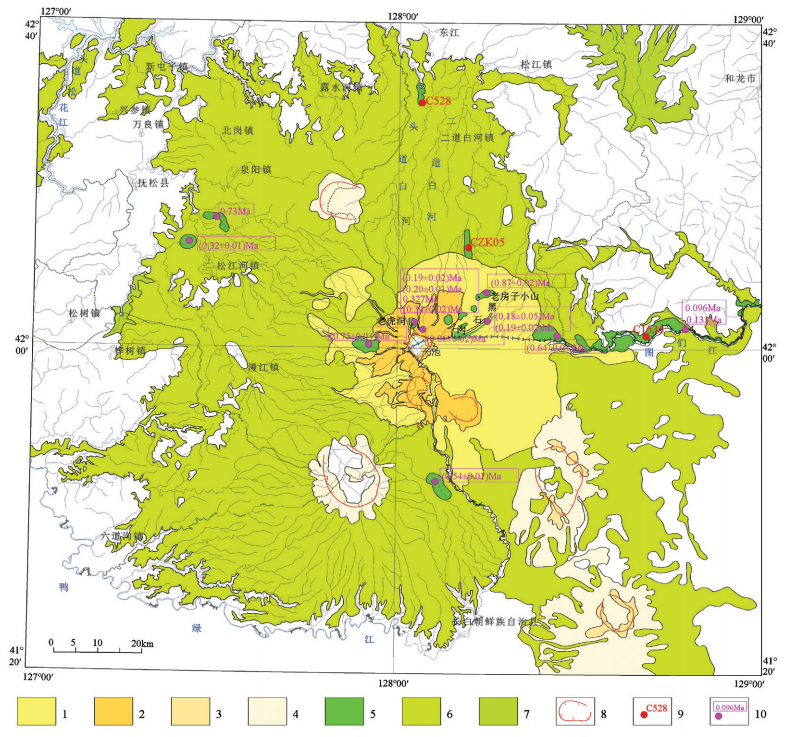
 下载:
下载:
